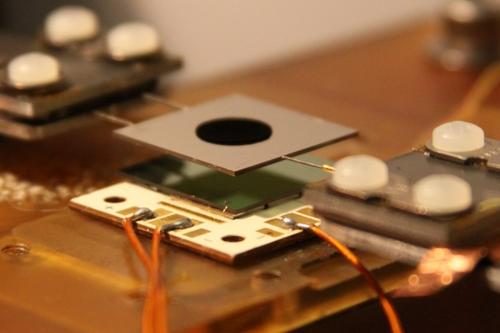Solar-Energy Conversion Goes Through the Roof 26538
MIT researchers have demonstrated a device that leverages thermophotovoltaics to break through the predicted ceiling for solar-cell conversion.
June 8, 2016
Thermophotovoltaics seems to be the next frontier for solar-power research, with scientists aiming to find ways to generate energy from the heat and light of the sun.
One of the latest efforts comes from a team of MIT researchers who has demonstrated a device that uses thermophotovoltaics to break through the predicted ceiling for how much sunlight can be converted into electricity in solar cells.
“Current solar cells are getting to the point where they perform just about as well as possible, given their fundamental limitations,” said David Bierman, a PhD student at MIT working on the project. “We are excited by thermophotovoltaics and their ability to surpass these limits by taking advantage of the entire solar spectrum, not just the spectral regions that solar cells are sensitive to.”
The Shockley-Queisser Limit, developed in 1961, has put an absolute theoretical limit on how efficient traditional solar cells can be in their energy conversion. For a single-layer cell made of silicon, which are the ones vastly used in today’s solar panels, the upper limit is about 32%.

Researchers at MIT have developed a device that pushes the assumed limits of solar-cell conversion by integrating thermophotovoltaic capability with typical photovoltaic-energy conversion.
(Source: MIT)
However, scientists like the MIT team have been working to push that limit in various ways, and heat is one of them. To achieve an efficiency with the potential to surpass the limit, Bierman and the MIT team used an intermediate component to absorb heat and then emit it as thermal radiation. With some tuning of materials and configuration, the cell could emit the radiation in the form of just the right wavelengths of light for the solar cell to capture.
”Incident sunlight is completely converted to heat, which is used to drive thermal emission of a tailored light spectrum on to a solar cell, Bierman explained. “The solar cell is completely shaded from the incident sunlight and thus solely illuminated by our manicured light spectrum.”
While the team only demonstrated efficiencies of 6.8% due to the use of a low-efficiency cell, Bierman said that when comparing the solar thermophotovoltaic system they created with a typical solar photovoltaic system, the potential for significant efficiency improvement was clear.
“In a direct comparison, we showed for the first time an improvement of the device efficiency by shading the photovoltaic cell from the sun with our absorber/emitter element,” he said.
READ MORE ARTICLES ON SOLAR ENERGY:
Bierman and MIT professors Evelyn Wang and Marin Soljačić, along with four others, published a paper on their work in the journal, Nature Energy.
In addition to improving the amount of solar energy that can be generated, using thermophotovoltaics also has an advantage over straight photovoltaic conversion in that it also can offer a more constant source of power, Bierman said.
“An additional advantage … is the ability to generate a continuous output power stream that is, in principle, independent of incident sunlight conditions,” he said. “This is one of the main practical challenges that large scale photovoltaic installations is facing today.”
The MIT team will continue its work to improve both its understanding and performance of the thermophotovoltaic device developed, Bierman said. Researchers also will incorporate new materials “to try to exploit different physical phenomena with the goal of improving the efficiency, robustness, and feasibility of the converter,” he added.
Elizabeth Montalbano is a freelance writer who has written about technology and culture for more than 15 years. She has lived and worked as a professional journalist in Phoenix, San Francisco and New York City. In her free time she enjoys surfing, traveling, music, yoga and cooking. She currently resides in a village on the southwest coast of Portugal.
About the Author(s)
You May Also Like
.jpg?width=300&auto=webp&quality=80&disable=upscale)


